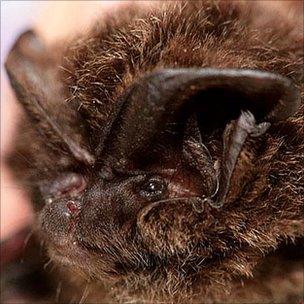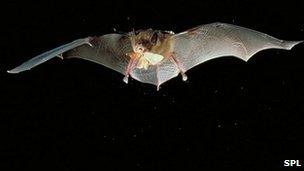Bat and moth arms race revealed
- Published
.jpg)
Many moths simply drop to the ground when they hear bats' clicks
Researchers have revealed more detail about the evolutionary "arms race" between bats and moths.
One study in the journal Current Biology has shown how a species of bat uses a quiet "stealth mode" of the clicks it uses to locate its prey.
Another from a Royal Society journal showed that a moth can distinguish between clicks that mean it has been spotted, and clicks that mean a strike.
This allows the moths to choose when to spend energy on defensive measures.
Moths live for just a few days and must evade predators and find a mate, often without eating.
Bats eat a wide array of insects but many species prefer the simple, high-nutrition snack that a moth provides.
They both navigate and hunt by emitting a stream of ultrasound clicks and listening for the echoes in a natural form of sonar, with the clicks repeating faster and faster as the bats close in on prey.

A stealth hunting technique may mean that Barbastella bats eat more nutrient-rich moths
Some moths, upon hearing the clicks, are known to reply with their own high-intensity clicks, or to fly erratically in looping evasive manoeuvres, or even to simply drop out of the sky.
The interplay between bats' strategies to hunt and the moths' strategies to avoid being eaten are frequently cited as a classic example of co-evolution.
"It often seems like predators and prey are going through a contiunous cycle or 'arms race', where each is trying to outwit the other," said Hannah ter Hofstede, the University of Bristol researcher who co-authored the Current Biology study.
"The predator is always trying to capture the prey and that selects for better defences in the prey. Over evolutionary timescales, that causes gradual changes in both groups."
Pitched battle
In a strategy that may be a moth-hunting adaptation, some bats are known to use clicks that are at a frequency, or pitch, either above or below moths' hearing ranges.
High-pitched clicks have a larger range, while lower-pitched clicks are absorbed less by the atmosphere It remains unclear whether these pitch-shifting techniques adapted specifically to bypass moth defences or simply to cope in certain environments or situations.
Dr ter Hofstede and her colleagues were able to listen in on the Barbastella bat as it hunted, demonstrating that it had a completely different approach - its clicks were much reduced in volume, becoming even quieter as it closed in on prey.
"It seems like the majority of bats... call very loudly because they need as much information as possible from their surroundings," Dr ter Hofstede told BBC News.
"We're saying that this [low-volume tactic] is an adaptation to get around the moths' defence - it doesn't have any other useful purpose."
While the lower volume of clicks reduces the range over which the bats can successfully hunt, the team showed that the approach leads to Barbastella bats eating significantly higher numbers of the nutrient-rich moths than other, louder species.
Breaking habits
Another study by John Ratcliffe of the University of Southern Denmark and his colleagues has shown how one species of moth is taking part in the arms race.
The team played bat clicks to the moths while measuring the impulses along the nerves in their ears, discovering evidence of a seemingly complex cost-benefit analysis.
Firstly, the moths responded differently to higher or lower click rates, showing an ability to discriminate between a bat that has only just noticed and one that is quickly closing in.
What is more, the team found that the "habituation" - the likelihood that after hearing them many times, the calls would elicit a response - was different for the high-risk compared to the low-risk calls.
The explanation is that a moth in a less threatening environment is well served by spending its energy and time avoiding capture when pursued only rarely by a predator. But a moth that finds itself frequently chased cannot spend all of its time diving and clicking, Dr Ratcliffe told BBC News.

Moths cannot always respond to the threat of an oncoming predator
"You've got five days to find youself a mate - hopefully a few mates - and if you're constantly being knocked out of the sky by the sound of bats or always producing sounds of really high intensity, you have a problem."
The more highly threatened moth must first and foremost find a mate and so take greater risks, responding less often to the calls of an oncoming predator.
"The moth is doing something more; it's not just 'push a button and the moth puts out a product', the moth is actually assessing and reassessing risks over and over again," said Dr Ratcliffe.
"We've got a bug that's using very little information but they're probably better gamblers than guys in the casino."